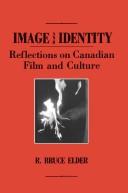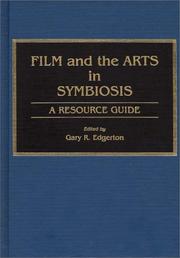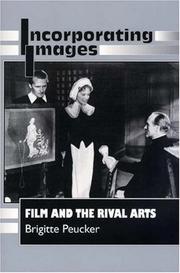| Listing 1 - 10 of 16 | << page >> |
Sort by
|
Book
ISBN: 1501709917 150172486X 9781501724855 1501724851 9781501724862 9781501709913 9781501726170 Year: 2018 Publisher: Ithaca, NY
Abstract | Keywords | Export | Availability | Bookmark
 Loading...
Loading...Choose an application
- Reference Manager
- EndNote
- RefWorks (Direct export to RefWorks)
In The Arts of Cinema, Martin Seel explores film's connections to the other arts and the qualities that distinguishe it from them. In nine concise and elegantly written chapters, he explores the cinema's singular aesthetic potential and uses specific examples from a diverse range of films-from Antonioni and Hitchcock to The Searchers and The Bourne Supremacy-to demonstrate the many ways this potential can be realized. Seel's analysis provides both a new perspective on film as a comprehensive aesthetic experience and a nuanced understanding of what the medium does to us once we are in the cinema.
Motion pictures and the arts. --- Motion pictures --- Arts and motion pictures --- Moving-pictures and the arts --- Arts --- Aesthetics --- Philosophy. --- Aesthetics.
Book
ISBN: 9780521529648 9780521822442 9780511674716 9780511675478 051167547X 0511674716 051167094X 9780511670947 9780511672224 0511672225 0521529646 0521822440 1107209617 0511739141 128248642X 9786612486425 0511674287 0511673493 Year: 2010 Publisher: Cambridge Cambridge University Press
Abstract | Keywords | Export | Availability | Bookmark
 Loading...
Loading...Choose an application
- Reference Manager
- EndNote
- RefWorks (Direct export to RefWorks)
A Philosophy of Cinematic Art is a systematic study of cinema as an art form, showing how the medium conditions fundamental features of cinematic artworks. It discusses the status of cinema as an art form, whether there is a language of film, realism in cinema, cinematic authorship, intentionalist and constructivist theories of interpretation, cinematic narration, the role of emotions in responses to films, the possibility of identification with characters, and the nature of the cinematic medium. Groundbreaking in its coverage of a wide range of contemporary cinematic media, it analyses not only traditional photographic films, but also digital cinema, and a variety of interactive cinematic works, including videogames. Written in a clear and accessible style, the book examines the work of leading film theorists and philosophers of film, and develops a powerful framework with which to think about cinema as an art.
Film --- Aesthetics --- Motion pictures and the arts. --- Motion pictures --- Aesthetics. --- Arts and motion pictures --- Moving-pictures and the arts --- Arts --- Arts and Humanities --- Philosophy
Book
ISBN: 025303440X 9780253034427 0253034426 9780253034403 9780253034397 0253034396 9780253034397 Year: 2018 Publisher: Bloomington, Indiana : Indiana University Press,
Abstract | Keywords | Export | Availability | Bookmark
 Loading...
Loading...Choose an application
- Reference Manager
- EndNote
- RefWorks (Direct export to RefWorks)
1. This book is a fascinating look at how early cinema and moving images inspired and were inspired by other more static forms of visual culture, such as painting, photography, and tableaux vivants. The contributors to this volume demonstrate how cinema responded to and was positioned within broader artistic and cultural frameworks. 2. This book is another strong contribution to the Proceedings of Domitor series, of which we are now the sole publishers. 3. It will benefit from our well established reputation in early cinema studies.
Cinematography. --- Motion pictures and the arts. --- Motion pictures --- Arts and motion pictures --- Moving-pictures and the arts --- Arts --- Photography --- Chronophotography --- Philosophy. --- Animated pictures

ISBN: 9780889208179 0889208174 0889209561 9780889209565 1554586771 1280925906 9786610925902 Year: 2006 Publisher: Waterloo Wilfrid Laurier University Press
Abstract | Keywords | Export | Availability | Bookmark
 Loading...
Loading...Choose an application
- Reference Manager
- EndNote
- RefWorks (Direct export to RefWorks)
Image and Identity examines the unique qualities of Canadian cinema, situating it within the broader spectrum of Canadian culture as a whole. Taking a genetic approach toward uncovering an answer to the ever-pressing Canadian question, ""In reality, who are we?"" Bruce Elder explores the essential features of Canadian thought and the distinctive Canadian philosophical traditions that developed in response to our particular historical and geographical circumstances. Arguing that this rich yet largely neglected tradition is still reflected in much of our current artistic practice, Eld
Culture in motion pictures. --- Experimental films --- Motion pictures and the arts --- Motion pictures --- Arts and motion pictures --- Moving-pictures and the arts --- Arts --- Avant-garde films --- Experimental videos --- Personal films --- Underground films --- Video art --- History. --- History and criticism.
Book
ISBN: 9048553660 9463724850 9048561884 Year: 2022 Publisher: Amsterdam : Amsterdam University Press,
Abstract | Keywords | Export | Availability | Bookmark
 Loading...
Loading...Choose an application
- Reference Manager
- EndNote
- RefWorks (Direct export to RefWorks)
Screening the Art World explores the ways in which artists and the art world more generally have been represented in cinema. Contributors address a rarely explored subject - art in cinema, rather than the art of cinema - by considering films across genres, historical periods, and national cinemas in order to reflect on cinema's fluctuating imaginary of art and the art world. The book examines the intersection of art history with history in cinema; cinema's simultaneous affirmation and denigration of the idea of art as "truth"; the dominant, often contradictory ways in which artists have been represented on screen; and cinematic representations of the art world's tenuous position between commercial good and cultural capital.
Motion pictures and the arts. --- ART / Film & Video. --- Arts and motion pictures --- Moving-pictures and the arts --- Arts --- cinema, visual arts, aesthetics. --- Art in motion pictures. --- Motion pictures --- Art in moving-pictures
Book
ISBN: 9089644717 9048517761 9789048517763 9789048517770 904851777X Year: 2020 Publisher: Baltimore, Maryland : Project Muse,
Abstract | Keywords | Export | Availability | Bookmark
 Loading...
Loading...Choose an application
- Reference Manager
- EndNote
- RefWorks (Direct export to RefWorks)
Explores the emergence of cinema as a primary medium of artistic production, offering an in-depth inquiry into its genesis, its defining features, and its ramifications. Erika Balsom also tackles cinema studies' great disciplinary obsession--namely, what cinema was, is, and will become in a digital future. Rich in theoretical reflections and critical analyses, Exhibiting Cinema in Contemporary Art offers insights into the whole history of cinema from the vantage point of today's art.
Art and motion pictures. --- Art in motion pictures. --- Motion picture industry -- Technological innovations. --- Motion pictures and the arts. --- Music, Dance, Drama & Film --- Film --- Motion picture industry --- Technological innovations. --- Arts and motion pictures --- Moving-pictures and the arts --- Film industry (Motion pictures) --- Moving-picture industry --- Art in moving-pictures --- Art and moving-pictures --- Motion pictures and art --- Arts --- Cultural industries --- Motion pictures

ISBN: 0313246491 Year: 1988 Publisher: Westport (Conn.) Greenwood
Abstract | Keywords | Export | Availability | Bookmark
 Loading...
Loading...Choose an application
- Reference Manager
- EndNote
- RefWorks (Direct export to RefWorks)
791.43 <03> --- Motion pictures and the arts --- #SBIB:309H1320 --- #SBIB:309H520 --- Arts and motion pictures --- Moving-pictures and the arts --- Arts --- Filmkunst. Films. Cinema--Naslagwerken. Referentiewerken --- De filmische boodschap: algemene werken (met inbegrip van algemeen filmhistorische werken en filmhistorische werken per land) --- Audiovisuele communicatie: algemene werken --- 791.43 <03> Filmkunst. Films. Cinema--Naslagwerken. Referentiewerken
Book
ISBN: 9789089648556 9089648550 9048527104 Year: 2017 Publisher: Amsterdam : Amsterdam University Press,
Abstract | Keywords | Export | Availability | Bookmark
 Loading...
Loading...Choose an application
- Reference Manager
- EndNote
- RefWorks (Direct export to RefWorks)
This collection for the first time brings together scholars to explore the ways that various people and groups in Italian society reacted to the advent of cinema. Looking at the responses of writers, scholars, clergymen, psychologists, philosophers, members of parliament, and more, the pieces collected here from that period show how Italians developed a common language to describe and discuss this invention that quickly exceeded all expectations and transcended existing categories of thought and artistic forms. The result is a close-up picture of a culture in transition, dealing with a "scandalous" new technology that appeared poised to thoroughly change everyday life.
Motion pictures --- Motion pictures and the arts --- History. --- Philosophy. --- Aesthetics. --- Social aspects --- Italy --- Intellectual life --- Arts and motion pictures --- Moving-pictures and the arts --- Arts --- Cinema --- Feature films --- Films --- Movies --- Moving-pictures --- Audio-visual materials --- Mass media --- Performing arts --- History and criticism --- early film theories, social impact of cinema, cinema and philosophy, cinema and psychology, cinema and war.
Book
ISBN: 0748670904 1283221799 9786613221797 0748647031 Year: 2011 Publisher: Edinburgh : Edinburgh University Press,
Abstract | Keywords | Export | Availability | Bookmark
 Loading...
Loading...Choose an application
- Reference Manager
- EndNote
- RefWorks (Direct export to RefWorks)
Through the feature films and documentaries of directors including Emmer, Erice, Godard, Hitchcock, Pasolini, Resnais, Rossellini and Storck, Jacobs examines the way films 'animate' artworks by means of cinematic techniques, such as camera movements and editing, or by integrating them into a narrative. He explores how this 'mobilization' of the artwork is brought into play in art documentaries and artist biopics, as well as in feature films containing key scenes situated in museums. The tension between stasis and movement is also discussed in relation to modernist cinema, which often includes tableaux vivants combining pictorial, sculptural and theatrical elements. This tension also marks the aesthetics of the film still, which have inspired prominent art photographers such as Cindy Sherman and Jeff Wall. Illustrated throughout, Jacobs' study of the presence of art in film, alongside the omnipresence of the filmic image in today's art museums, is an engaging work for students and scholars of film and art alike.
Motion pictures and the arts. --- Arts. --- Arts, Fine --- Arts, Occidental --- Arts, Western --- Fine arts --- Humanities --- Arts and motion pictures --- Moving-pictures and the arts --- Arts --- Art and motion pictures. --- Motion pictures --- Appreciation. --- Philosophy. --- Appreciation of motion pictures --- Art and moving-pictures --- Motion pictures and art

ISBN: 140086402X 0691600678 0691002819 9781400864027 Year: 2014 Publisher: Princeton, NJ
Abstract | Keywords | Export | Availability | Bookmark
 Loading...
Loading...Choose an application
- Reference Manager
- EndNote
- RefWorks (Direct export to RefWorks)
Film, a latecomer to the realm of artistic media, alludes to, absorbs, and undermines the discourses of the other arts--literature and painting especially--in order to carve out a position for itself among them. Exposing the anxiety in film's relation to its rival arts, Brigitte Peucker analyzes central issues involved in generic boundary crossing as they pertain to film and situates them in a theoretical framework. The figure of the human body takes center stage in Peucker's innovative study, for it is through this figure that the conjunction of literary and painterly discourses persistently articulates itself. It is through the human body, too, that film's consciousness of itself as a hybrid text and as a "machine for simulation" makes itself deeply felt.In films ranging from Weimar cinema through Griffith, Hitchcock, and Greenaway, Peucker probes issues in aesthetics problematized by Diderot and Kleist, among others. She argues that the introduction of movement into visual representation occasioned by film brings with it an underlying tension suggestive of castration and death. Peucker goes on to demonstrate how the encounter between narrative and image is both gendered and sexualized, rendering film a "monstrous" hybrid. In a final section, she explores in specific cinematic texts the permeable boundary between the real and representation, suggesting how effects such as tableau vivant and trompe l'oeil figure sexuality and death.Originally published in 1995.The Princeton Legacy Library uses the latest print-on-demand technology to again make available previously out-of-print books from the distinguished backlist of Princeton University Press. These editions preserve the original texts of these important books while presenting them in durable paperback and hardcover editions. The goal of the Princeton Legacy Library is to vastly increase access to the rich scholarly heritage found in the thousands of books published by Princeton University Press since its founding in 1905.
#SBIB:309H1321 --- Brigitte Peucker --- film en literatuur --- Wiene Robert --- film en feminisme --- Films met een amusementsfunctie en/of esthetische functie: algemeen --- Motion pictures and the arts --- Motion pictures --- 791.41 --- film --- film en psychoanalyse --- film en schilderkunst --- filmtheorie --- gender studies --- Greenaway Peter --- Griffith David Wark --- Hitchcock Alfred --- Lang Fritz --- 791.43 --- 791.43 Filmkunst. Films. Cinema --- Filmkunst. Films. Cinema --- Aesthetics --- Arts and motion pictures --- Moving-pictures and the arts --- Arts --- Motion pictures and the arts. --- Aesthetics. --- PERFORMING ARTS / Film & Video / History & Criticism.
| Listing 1 - 10 of 16 | << page >> |
Sort by
|

 Search
Search Feedback
Feedback About UniCat
About UniCat  Help
Help News
News